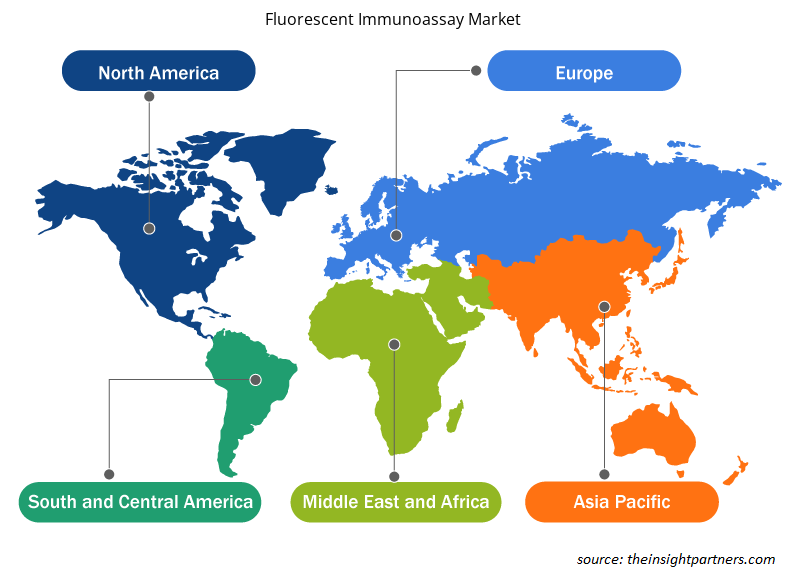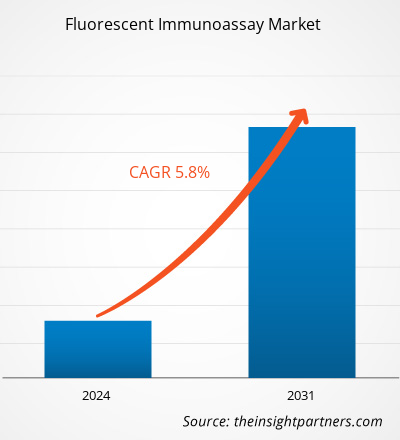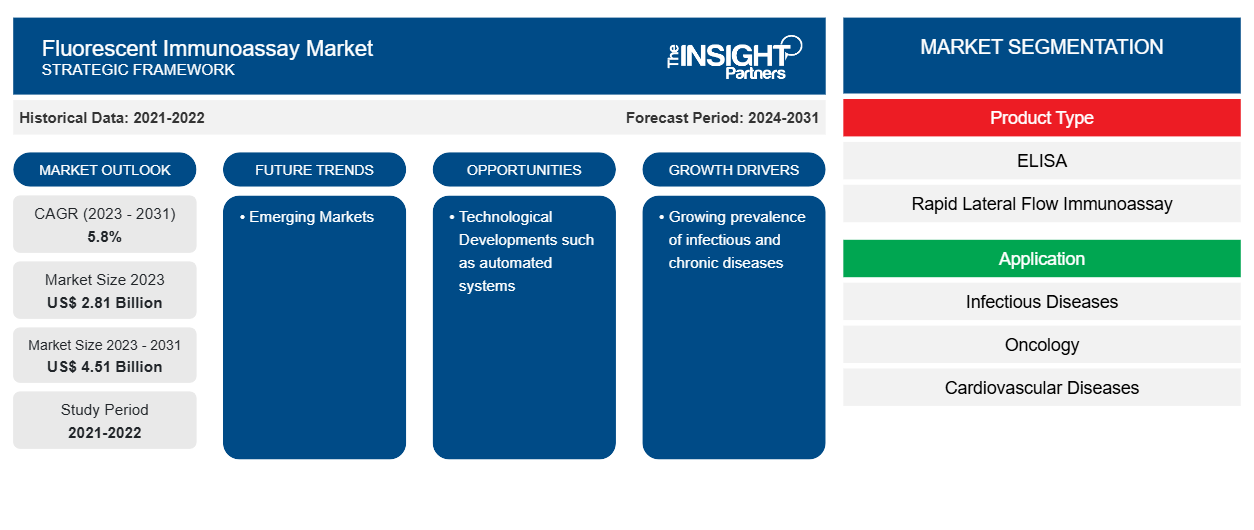Si prevede che la dimensione del mercato dell'immunoanalisi fluorescente raggiungerà i 4,51 miliardi di dollari entro il 2031, rispetto ai 2,81 miliardi di dollari del 2023. Si prevede che il mercato registrerà un CAGR del 5,8% nel periodo 2023-2031. È probabile che i dispositivi portatili per l'immunoanalisi fluorescente per i test point-of-care rimangano tendenze chiave nel mercato.immunoassay market size is projected to reach US$ 4.51 billion by 2031 from US$ 2.81 billion in 2023. The market is expected to register a CAGR of 5.8% during 2023–2031. Portable fluorescent immunoassay devices for point of care testing are likely to remain key trends in the market.
Analisi di mercato dell'immunoanalisi fluorescenteImmunoassay Market Analysis
La crescente prevalenza di malattie infettive è il fattore chiave che guida la crescita del mercato. Gli immunoassaggi fluorescenti sono ampiamente utilizzati nella diagnosi di malattie infettive come COVID-19, HIV, epatite, tra le altre. Secondo l'Organizzazione mondiale della sanità (OMS), a dicembre 2023, 39,9 milioni di pazienti vivevano con l'HIV, di cui 1,4 milioni erano bambini (0-14 anni) e 38,6 milioni erano adulti (15+ anni).immunoassays are widely used in diagnosis of infectious diseases such as COVID-19, HIV, Hepatitis among others. As per the World Health Organization (WHO), in December 2023, 39.9 million patients were living with HIV of which 1.4 million were children (0–14 years old) and 38.6 million were adults (15+ years old).
Panoramica del mercato dell'immunoanalisi fluorescenteImmunoassay Market Overview
La crescente prevalenza di malattie infettive e croniche , gli sviluppi tecnologici quali le capacità di multiplexing, i sistemi automatizzati di immunoanalisi a fluorescenza, lo sviluppo di dispositivi portatili, l'espansione delle applicazioni di immunoanalisi a fluorescenza in settori quali l'oncologia, le malattie neurologiche, tra gli altri, l'integrazione con la salute digitale, la semplificazione dei percorsi normativi, uno scenario di rimborso favorevole e le crescenti attività di ricerca e sviluppo per sviluppare nuovi test e kit sono fattori che guidano la crescita del mercato degli immunoanalisi a fluorescenza.immunoassay systems, development of portable devices, expanding applications of fluorescent immunoassays in areas such as oncology, neurological diseases, among others, integration with digital health, streamline regulatory pathways, favourable reimbursement scenario, and growing research and development activities to develop new assay and kits are factors driving the growth of the fluorescent immunoassay market.
Personalizza questo report in base alle tue esigenze
Riceverai la personalizzazione gratuita di qualsiasi report, comprese parti di questo report, o analisi a livello nazionale, pacchetto dati Excel, oltre a usufruire di grandi offerte e sconti per start-up e università
-
Scopri le principali tendenze di mercato in questo rapporto.Questo campione GRATUITO includerà analisi di dati che spaziano dalle tendenze di mercato alle stime e alle previsioni.
Driver e opportunità del mercato dell'immunoanalisi fluorescenteImmunoassay Market Drivers and Opportunities
La crescente prevalenza del cancro probabilmente farà aumentare la domanda di immunoanalisi fluorescente.Immunoassay.
Gli immunoassaggi fluorescenti aiutano a rilevare i biomarcatori del cancro, che aiutano nello screening precoce del cancro , nella diagnosi e nella prognosi. Secondo l'American Cancer Society, nel 2022 si sono verificati circa 20 milioni di casi di cancro in tutto il mondo e si prevede che il numero di casi di cancro raggiungerà i 35 milioni entro il 2050. Un carico così elevato di casi di cancro in tutto il mondo probabilmente aumenterà la domanda di immunoassaggi fluorescenti.immunoassays help detect cancer biomarkers, which help in early immunoassay.
Mercati emergenti
La crescente spesa sanitaria, il miglioramento delle infrastrutture sanitarie e la crescente prevalenza di malattie infettive e croniche probabilmente creeranno opportunità di crescita per il mercato dell'immunoanalisi fluorescente nei mercati emergenti. Ad esempio, il Ministero della Salute e del Benessere della Famiglia ha stanziato 90.659 crore di rupie (10,93 miliardi di dollari), con un aumento dell'1,69% rispetto alle 89.155 crore di rupie (10,75 miliardi di dollari) del 2023-24.immunoassay market in emerging markets. For instance, the Ministry of Health and Family Welfare allocated Rs. 90,659 crore (US$ 10.93 billion), which is an increase of 1.69% compared to Rs. 89,155 crore (US$ 10.75 billion) in 2023-24.
Analisi della segmentazione del rapporto di mercato dell'immunoanalisi fluorescenteImmunoassay Market Report Segmentation Analysis
I segmenti chiave che hanno contribuito alla derivazione dell'analisi di mercato dell'immunoanalisi fluorescente sono il prodotto e l'utente finale.immunoassay market analysis are product, and end user.
- Il mercato globale degli immunoassay fluorescenti, in base al tipo di prodotto, è segmentato in ELISA, immunoassay a flusso laterale rapido e altri. Nel 2023, il segmento ELISA ha detenuto la quota maggiore del mercato. Inoltre, si prevede che lo stesso segmento assisterà anche alla crescita più rapida durante il periodo di previsione, a causa dell'aumento del rilevamento e della diagnosi di varie condizioni mediche in tutto il mondo.immunoassay market, based on product type is segmented into ELISA, rapid lateral flow immunoassay and others. In 2023, the ELISA segment held the largest share of the market. Moreover, the same segment is also expected to witness fastest growth during the forecast period, owing to the rise in the detection and diagnosis of various medical conditions across the globe.
- In base all'applicazione, il mercato dell'immunoanalisi fluorescente è segmentato in malattie infettive, oncologia, malattie cardiovascolari e altri. Nel 2021, il segmento delle malattie infettive ha detenuto la quota maggiore del mercato e si prevede che lo stesso segmento registrerà anche la crescita più rapida durante il periodo di previsione, a causa dell'aumento della prevalenza di malattie infettive in tutto il mondo.immunoassay market is segmented into infectious diseases, oncology, cardiovascular diseases, others. In 2021, the infectious diseases segment held the largest share of the market and the same segment is also expected to witness fastest growth duringthe forecast period, owing to the rise in the prevalence of infectious diseases across the globe.
- In base alla via di somministrazione, il mercato globale degli immunodosaggi fluorescenti è suddiviso in applicazioni endovenose, sottocutanee e altre. Il segmento endovenoso ha detenuto la quota maggiore del mercato nel 2023 e si prevede che crescerà al CAGR più elevato durante il periodo di previsione.immunoassay market is divided into intravenous, subcutaneous, and other applications. The intravenous segment held the largest share of the market in 2023 and is expected to grow at the highest CAGR during the forecast period.
- In base all'utente finale, il mercato globale dell'immunoanalisi fluorescente è segmentato in Ospedali e cliniche, centri diagnostici, aziende farmaceutiche e biotecnologiche, istituti accademici e di ricerca e altri. Il segmento degli ospedali ha detenuto la quota maggiore del mercato nel 2023 e si prevede che lo stesso segmento registrerà il CAGR più elevato nel mercato durante il periodo di previsione.immunoassay market is segmented into Hospitals & Clinics, diagnostic centers, Pharmaceutical & Biotechnology Companies, Academic & Research Institutes, and others. The hospitals segment held the largest share of the market in 2023 and the same segment is anticipated to register the highest CAGR in the market during the forecast period.
Analisi della quota di mercato dell'immunoanalisi fluorescente per area geograficaImmunoassay Market Share Analysis by Geography
L'ambito geografico del rapporto di mercato sui test immunoenzimatici a fluorescenza è suddiviso principalmente in cinque regioni: Nord America, Asia Pacifico, Europa, Medio Oriente e Africa, Sud e Centro America.immunoassay market report is mainly divided into five regions: North America, Asia Pacific, Europe, Middle East & Africa, and South & Central America.
La regione del Nord America detiene la quota di mercato più grande, mentre la regione Asia-Pacifico è la regione in più rapida crescita. La crescita del mercato in Nord America è dovuta principalmente alla crescente domanda di immunoassay fluorescenti, poiché gli Stati Uniti e il Canada stanno sperimentando un numero crescente di attività di ricerca e sviluppo e investimenti crescenti in attività di diagnostica clinica da parte di attori chiave del mercato. Inoltre, l'Asia-Pacifico è il mercato globale in più rapida crescita per gli immunoassay fluorescenti. Cina, India e Giappone sono tre importanti contributori alla crescita del mercato. I fattori che contribuiscono alla crescita del mercato degli immunoassay fluorescenti in questi paesi sono l'aumento dei casi di malattie croniche nel corso degli anni. Si stima che paesi come Australia, India e Corea del Sud offrano varie opportunità di crescita grazie al crescente sviluppo nel settore sanitario.immunoassays as the US and Canada are experiencing growing numbers of research and development activities and rising investments in clinical diagnostic businesses by key market players. Moreover, Asia Pacific is the fastest-growing global market for fluorescent immunoassays. China, India, and Japan are three major contributors to the growth of the market. The factors contributing to the growth of the fluorescent immunoassay market in these countries are the rise in cases of chronic diseases over the years. Countries such as Australia, India, and South Korea are estimated to serve various growth opportunities due to the rising development in the healthcare sector.
Approfondimenti regionali sul mercato dell'immunoanalisi fluorescente
Le tendenze regionali e i fattori che influenzano il mercato dell'immunoanalisi fluorescente durante il periodo di previsione sono stati ampiamente spiegati dagli analisti di Insight Partners. Questa sezione discute anche i segmenti e la geografia del mercato dell'immunoanalisi fluorescente in Nord America, Europa, Asia Pacifico, Medio Oriente e Africa e America centrale e meridionale.

- Ottieni i dati specifici regionali per il mercato dell'immunoanalisi fluorescente
Ambito del rapporto di mercato dell'immunoanalisi fluorescente
| Attributo del report | Dettagli |
|---|---|
| Dimensioni del mercato nel 2023 | 2,81 miliardi di dollari USA |
| Dimensioni del mercato entro il 2031 | 4,51 miliardi di dollari USA |
| CAGR globale (2023-2031) | 5,8% |
| Dati storici | 2021-2022 |
| Periodo di previsione | 2024-2031 |
| Segmenti coperti |
Per tipo di prodotto
|
| Regioni e Paesi coperti |
America del Nord
|
| Leader di mercato e profili aziendali chiave |
|
Densità dei player del mercato dell'immunoanalisi fluorescente: comprendere il suo impatto sulle dinamiche aziendali
Il mercato del Fluorescent Immunoassay Market sta crescendo rapidamente, spinto dalla crescente domanda degli utenti finali dovuta a fattori quali l'evoluzione delle preferenze dei consumatori, i progressi tecnologici e una maggiore consapevolezza dei benefici del prodotto. Con l'aumento della domanda, le aziende stanno ampliando le loro offerte, innovando per soddisfare le esigenze dei consumatori e capitalizzando sulle tendenze emergenti, il che alimenta ulteriormente la crescita del mercato.
La densità degli operatori di mercato si riferisce alla distribuzione di aziende o società che operano in un particolare mercato o settore. Indica quanti concorrenti (operatori di mercato) sono presenti in un dato spazio di mercato in relazione alle sue dimensioni o al valore di mercato totale.
Le principali aziende che operano nel mercato dell'immunoanalisi fluorescente sono:
- Abate
- BD
- bioMérieux SA
- Società anonima F. Hoffman-La Roche Ltd.
- Siemens AG
- Società per azioni Sysmex Corp.
Disclaimer : le aziende elencate sopra non sono classificate secondo un ordine particolare.

- Ottieni una panoramica dei principali attori del mercato dell'immunoanalisi fluorescente
Notizie e sviluppi recenti sul mercato dell'immunoanalisi fluorescente
Il mercato degli immunodosaggi fluorescenti viene valutato raccogliendo dati qualitativi e quantitativi post-ricerca primaria e secondaria, che includono importanti pubblicazioni aziendali, dati di associazioni e database. Di seguito sono elencati alcuni degli sviluppi nel mercato degli immunodosaggi fluorescenti:
- Roche ha annunciato di aver lanciato un test antigenico SARS-CoV-2 ad alto rendimento come ausilio nella diagnosi delle infezioni da SARS-CoV-2. Il test antigenico SARS-CoV-2 Elecsys basato su laboratorio aveva precedentemente ricevuto il marchio CE e ha recentemente ottenuto la licenza di importazione da CDSCO (Fonte: F. Hoffmann-La Roche Ltd., Comunicato stampa, giugno 2021)
- Ortho Clinical Diagnostics ha annunciato che il suo test quantitativo per gli anticorpi IgG COVID-19 ha ottenuto il marchio CE. Il test quantitativo per gli anticorpi IgG anti-SARS-CoV-2 VITROS di Ortho è tracciabile allo standard internazionale dell'OMS per gli anticorpi IgG anti-SARS-CoV-2, sviluppato per facilitare la standardizzazione dei metodi sierologici SARS-CoV-2. (Fonte: Ortho Clinical Diagnostics, Newsletter, maggio 2021)
- Ortho Clinical Diagnostics ha annunciato che la FDA statunitense ha concesso l'autorizzazione all'uso di emergenza al suo secondo test sugli anticorpi COVID-19: il test VITROS Immunodiagnostic Products Anti-SARS-CoV-2 IgG (test sugli anticorpi COVID-19 IgG). (Fonte: Ortho Clinical Diagnostics, Newsletter, aprile 2021)
Copertura e risultati del rapporto sul mercato dell'immunoanalisi fluorescente
Il rapporto "Dimensioni e previsioni del mercato dell'immunoanalisi fluorescente (2021-2031)" fornisce un'analisi dettagliata del mercato che copre le seguenti aree:
- Dimensioni e previsioni del mercato degli immunoassay fluorescenti a livello globale, regionale e nazionale per tutti i principali segmenti di mercato coperti dall'ambito
- Tendenze del mercato dell'immunoanalisi fluorescente e dinamiche di mercato come fattori trainanti, limitazioni e opportunità chiave
- Analisi dettagliata delle cinque forze PEST/Porter e SWOT
- Analisi di mercato dell'immunoanalisi fluorescente che copre le principali tendenze di mercato, il quadro globale e regionale, i principali attori, le normative e i recenti sviluppi del mercato
- Analisi del panorama industriale e della concorrenza che copre la concentrazione del mercato, l'analisi della mappa di calore, i principali attori e gli sviluppi recenti per il mercato dell'immunoanalisi fluorescente
- Profili aziendali dettagliati
- Analisi storica (2 anni), anno base, previsione (7 anni) con CAGR
- Analisi PEST e SWOT
- Valore/volume delle dimensioni del mercato - Globale, Regionale, Nazionale
- Industria e panorama competitivo
- Set di dati Excel
Report recenti
Testimonianze
Motivo dell'acquisto
- Processo decisionale informato
- Comprensione delle dinamiche di mercato
- Analisi competitiva
- Analisi dei clienti
- Previsioni di mercato
- Mitigazione del rischio
- Pianificazione strategica
- Giustificazione degli investimenti
- Identificazione dei mercati emergenti
- Miglioramento delle strategie di marketing
- Aumento dell'efficienza operativa
- Allineamento alle tendenze normative























 Ottieni un campione gratuito per - Mercato dei test immunoenzimatici fluorescenti
Ottieni un campione gratuito per - Mercato dei test immunoenzimatici fluorescenti